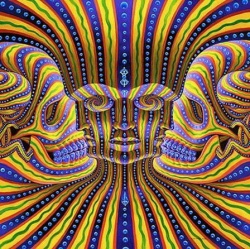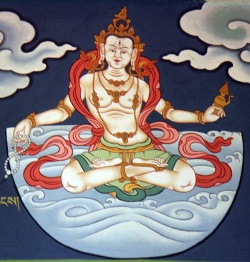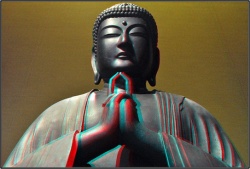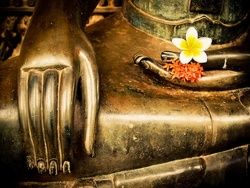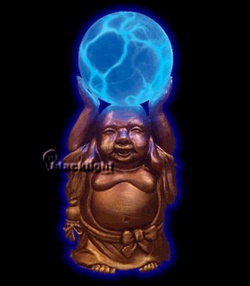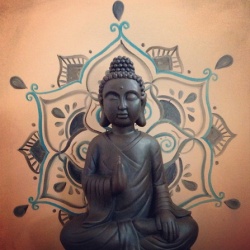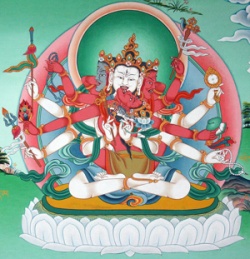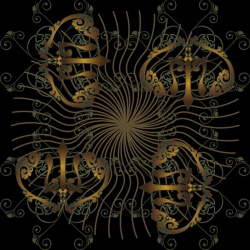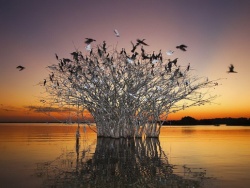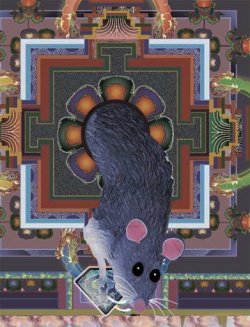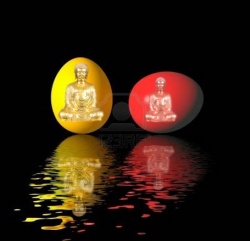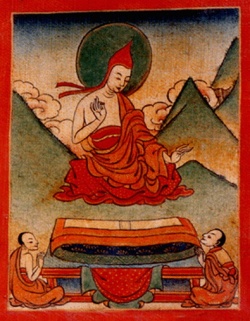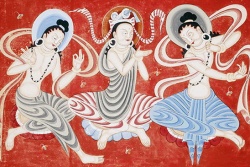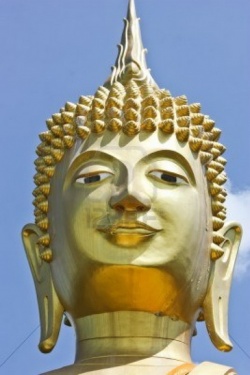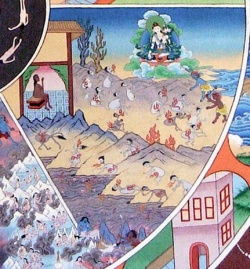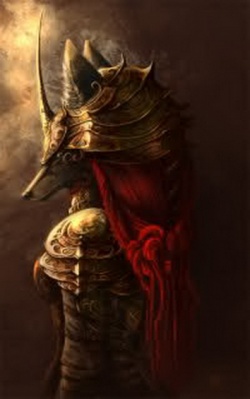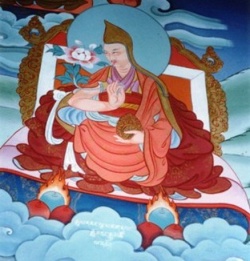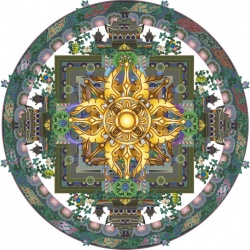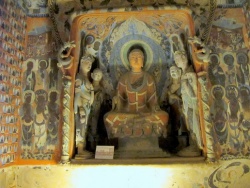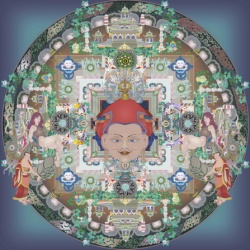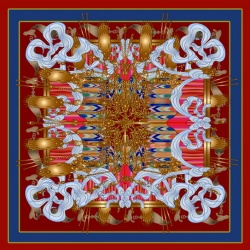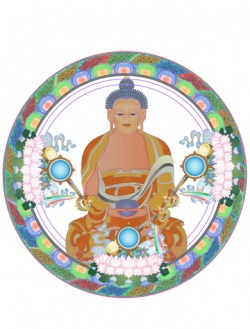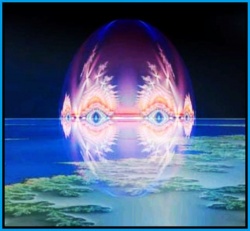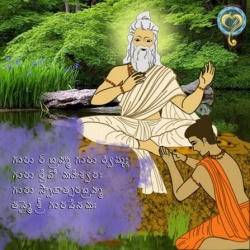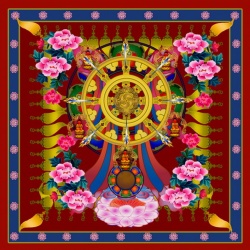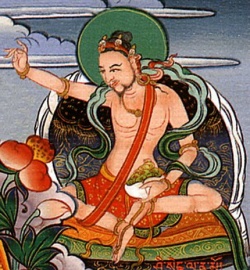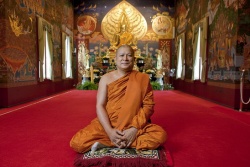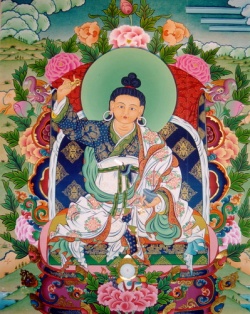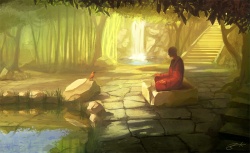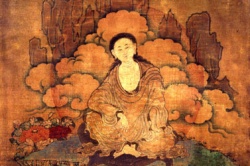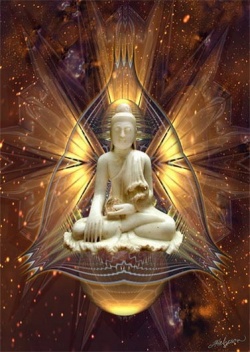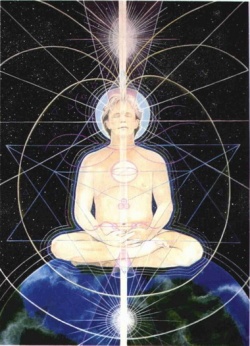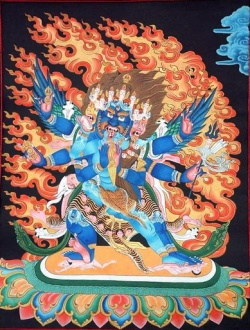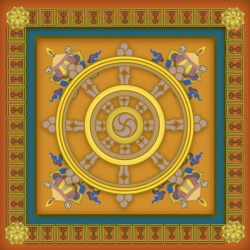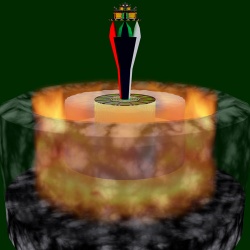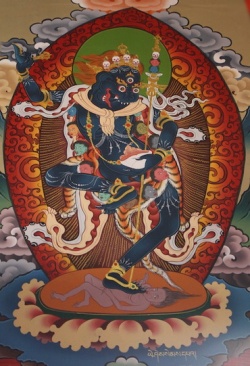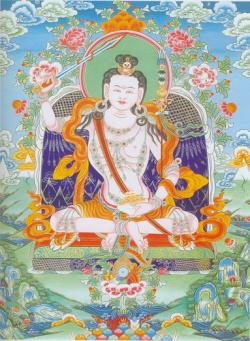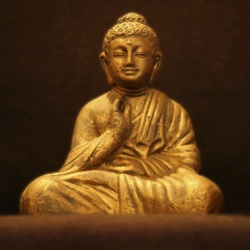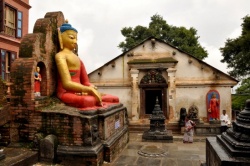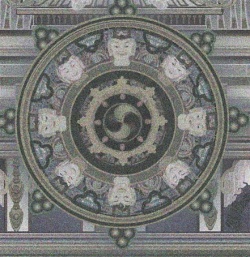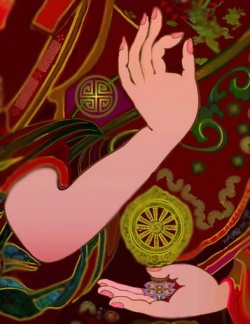Shambhala, The Resplendent
Lama, tell me of Shambhala!” “But you Westerners know nothing about Shambhala—you wish to know nothing. Probably you ask only out of curiosity; and you pronounce this sacred word in vain.”
“Lama, I do not ask about Shambhala aimlessly.
Everywhere, people know of this great symbol under different names. Our scientists seek each spark concerning this remarkable realm. Csoma de Koros knew of Shambhala,when he made his prolonged visit to the Buddhist monasteries. Grunwedel translated the book of the famous Tashi Lama, Pal-den ye -she, about ‘The Way to Shambhala.’
We sense how, under secret symbols, a great truth is concealed. Truly, the ardent scientist desires to know all about Kalachakra.”
“Can this be so, when some of your Western people desecrate our temples?
They smoke within our holy sanctuaries; they neither understand nor wish to venerate our faith and our teaching.
They mock and deride the symbols whose meaning they do not penetrate. Should we visit your temples, our conduct would be completely different, because your great Bodhisattva, Issa, is verily an exalted one.
And none of us would defame the teaching of mercy and righteousness.”
“Lama, only the very ignorant and stupid would ridicule your teaching.
All the teachings of righteousness are as in one sacred place. And each one possessed of his senses, will not violate the sacred places. Lama, why do you think that the essential teaching of the Blessed One is unknown to the West?
Why do you believe that in the West we do not know of Shambhala?
“Lama, upon my very table you may see the Kalachakra, the Teaching brought by the great Atticha from India. I know that if a high spirit, already prepared, hears a voice proclaiming Kalagiya it is the call to Shambhala.
We know which Tashi Lama visited Shambhala.
We know the book of the High Priest, T’aishan —‘The Red Path to Shambhala.’ We even know the Mongolian song about Shambhala. Who knows—perhaps we even know many things new to you. We know that quite recently a young Mongolian lama issued a new book about Shambhala.”
The Lama studies us with his piercing glance. Then he says:
“Great Shambhala is far beyond the ocean. It is the mighty heavenly domain. It has nothing to do with our earth. How and why do you earthly people take interest in it? Only in some places, in the Far North, can you discern the resplendent rays of Shambhala.”
“Lama, we know the greatness of Shambhala. We know the reality of this indescribable realm. But we also know about the reality of the earthly Shambhala.
We know how some high lamas went to Shambhala, how along their way they saw the customary physical things. We know the stories of the Buryat lama, of how he was accompanied through a very narrow secret passage.
We know how another visitor saw a caravan of hill-people with salt from the lakes, on the very borders of Shambhala. Moreover, we ourselves have seen a white frontier post of one of the three outposts of Shambhala.
So, do not speak to me about the heavenly Shambhala only, but also about the one on earth; because you know as well as I, that on earth Shambhala is connected with the heavenly one.
And in this link, the two worlds are unified.” The Lama becomes silent.
With eyes half concealed by the lids, he examines our faces. And in the evening dusk, he commences his tale: “Verily, the time is coming when the Teaching of the Blessed One will once again come from the North to the South.
The word of Truth, which started its great path from Bodhigaya, again shall return to the same sites.
We must accept it simply, as it is: the fact that the true teaching shall leave Tibet, and shall again appear in the South. And in all countries, the covenants of Buddha shall be manifested.
Really, great things are coming. You come from the West, yet you are bringing news of Shambhala. We must take it verily so. Probably the ray from the tower of Rigden-jyepo has reached all countries.
“Like a diamond glows the light on the Tower of Shambhala. He is there—Rigden-jyepo, indefatigable, ever vigilant in the cause of mankind. His eyes never close. And in his magic mirror he sees all events of earth.
And the might of his thought penetrates into far-off lands. Distance does not exist for him; he can instantaneously bring assistance to worthy ones. His powerful light can destroy all darkness.
His immeasurable riches are ready to aid all needy ones who offer to serve the cause of righteousness. He may even change the karma of human beings…”
“Lama, it seems to me that you speak of Maitreya; is it not so?”
“We must not pronounce this mystery! There is much which may not be revealed. There is much which may not be crystallized into sound. In sound we reveal our thought.
In sound we project our thought into space and the greatest harm may follow. Because everything divulged before the destined date, results in untold harm. Even the greatest catastrophies may be provoked by such light-minded acts.
If Rigden-jyepo and the Blessed Maitreya are one and the same for you—let it be so. I have not so stated!
“Uncountable are the inhabitants of Shambhala. Numerous are the splendid new forces and achievements which are being prepared there for humanity…” “Lama, the Vedanta tells us that very soon new energies shall be given to humanity. Is this true?”
“Innumerable are the great things predestined and prepared. Through the Holy Scriptures we know of the Teaching of the Blessed One about the inhabitants of the distant stars.
From the same source we have heard of the flying steel bird . . . about iron serpents which devour space with fire and smoke. Tathagata, the Blessed One, predicted all for the future.
He knew how the helpers of Rigden-jyepo would be reincarnated in due time; how the sacred army would purge Lhassa of all its nefarious enemies; and how the realm of righteousness would be established.”
“Lama, if the great warriors are incarnated, will not the activities of Shambhala take place here on our earth?” “Everywhere—here and in heaven.
All benevolent forces shall come together to destroy the darkness. Each one who will help in this great task shall be rewarded a hundred-fold and upon this very earth, in this incarnation.
All sinners against Shambhala will perish in this very incarnation, because they have exhausted mercy.”
“Lama, you know the truth. Then tell me why there are so many unworthy priests.”
“Certainly this is not an excuse: but if the Teaching must move to the South then it is not surprising that many learned lamas have left Tibet. In the West, do they know that Pan-chen-rinpoche (the Tashi Lama) is connected with Shambhala?”
“Lama, we certainly know that Pan-chen-rinpoche is greatly esteemed everywhere. In different countries we have heard how highly not only Buddhists, but the people of many nations, talk about His Holiness.
It is even said that in his private apartments, long before his departure, the details of his coming travels were outlined in the frescoes. We know that Pan-chen-rinpoche follows the customs of all the great lamas.
We have been told how during his flight he and his followers escaped many of the greatest dangers.
“We know how at one time his pursuers from Lhassa were already quite upon him, when a heavy snowfall cut off the pursuers’ road. Another day, Pan-chen-rinpoche arrived at a lake in the mountains; a difficult problem confronted him. His enemies were close behind; but in order to escape, it would be necessary for him to make a long circuit around the lake.
Thereupon, Pan-chen-rinpoche sat in deep meditation for some time.
Arousing himself, he gave orders, that despite the danger, the entire caravan would have to spend the night on the shores of the lake. Then the unusual happened:
During the night, a heavy frost arose, which covered the lake with ice and snow. Before sunrise, while it was still dark, Tashi Lama gave orders to his people to move on speedily, and he, with his three hundred followers, crossed the lake over the ice by the shortest way,
thus escaping danger. When the enemies arrived at the same spot, the sun was already high and its rays had melted the ice. There remained for them only the roundabout way. Was it not so?”
“Verily, so it was. Pan-chen-rinpoche was helped by Holy Shambhala throughout his travels. He saw many wondrous signs when he crossed the uplands hastening to the North.”
“Lama, not far from Ulan-Davan we saw a huge black vulture which flew low, close to our camp. He crossed the direction of something shining and beautiful, which was flying south over our camp, and which glistened in the rays of the sun.”
The eyes of the Lama sparkled. Eagerly he asked:
“Did you also feel the perfumes of the temple-incenses in the desert?” “Lama, you are quite right—in the stony desert, several days from any habitation, many of us became simultaneously aware of an exquisite breath of perfume.
This happened several times. We never smelt such lovely perfume. It reminded me of certain incense which a friend of mine once gave me in India—from where he obtained it, I do not know.”
“Ah—you are guarded by Shambhala. The huge black vulture is your enemy, who is eager to destroy your work, but the protecting force from Shambhala follows you in this Radiant form of Matter.
This force is always near to you but you cannot always perceive it. Sometimes only, it is manifested for strengthening and directing you.
Did you notice the direction in which this sphere moved? You must follow the same direction. You mentioned to me the sacred call—Kalagiya!
When some one hears this imperative call, he must know that the way to Shambhala is open to him. He must remember the year when he was called, because from that time evermore, he is closely assisted by the Blessed Rigden-jyepo.
Only you must know and realize the manner in which people are helped, because often people repel the help which is sent.”
“Lama, tell me how are the simple people helped by Shambhala? We know of the adepts and of incarnate co-workers of Shambhala. But in what manner does the might of Shambhala manifest itself among the humble?”
“In untold and manifold ways. Each one who in previous incarnations followed the teaching of righteousness and was useful to the Common Cause, is helped by this Common Cause. Not many years ago during the war and unrest, one man asked a lama if he should change his dwelling.
The lama answered that he could remain in the same place for about six months longer, but that afterwards he would be in great danger and would have to flee without delay. During the six months which followed, the man was most successful in his work; everything was peaceful and his possessions multiplied.
When the six months had expired, he thought, ‘Why should I risk my property by leaving this quiet spot? Everything seems so prosperous for me and there is apparently no danger. Probably the lama was mistaken.’
“But the cosmic flux was not arrested. And the predestined danger suddenly arose. The troops of the enemies approached the place at full speed from both directions.
And the man realized that his best opportunity had been lost and his way was now cut off. He hurried to the same lama and told him of what had happened.
“The lama told him that for certain reasons it was necessary that he be saved—‘But,’ he added, ‘it is now more difficult to help you. The best opportunity is lost, but I still can do something for you.
To-morrow, take your family with you and ride towards the North. On the road you will meet your enemies. This is inevitable. When you see them coming, go away from the road and remain quiet. Even though they may approach you, even though they speak to you, remain quiet and unmoving until they pass.’
“So it happened. The man, with his family and belongings, set out at early morning. Suddenly in the dusk of morning, they distinguished the outlines of soldiers rapidly approaching. They turned aside from the road and stood silent, tense.
“The soldiers hurriedly approached, and the poor man heard one of them shouting, ‘Here they are. I see people here.
Probably there is a nice booty for us.’
“Another one laughingly answered him, ‘Friend, you probably slept poorly last night, since you cannot distinguish stones from humans. They are quite near us and you say that they are not stones!’
“The first one insisted, ‘But I even see a horse!’ The other one laughed.
“ ‘On such a stony horse, you will not ride far. Could you imagine that a horse, aware of all our horses, would remain immovable?’ “The soldiers all laughed heartily and, deriding the mistake of the first one, passed quite close to the immovable group.
They then disappeared into the mist. Thus, even in the most difficult situation, the man was saved.
For he had been useful to Shambhala just once.
“Shambhala knows all. But the secrets of Shambhala are well guarded.”
“Lama, how are the secrets of Shambhala guarded? It is said that many co-workers of Shambhala, many messengers, are speeding through the world. How can they preserve the secrets entrusted to them?”
“The great keepers of mysteries are watching closely all those to whom they have entrusted their work and given high missions. If an unexpected evil confronts them they are helped immediately. And the entrusted treasure shall be guarded.
About forty years ago, a great secret was entrusted to a man living in the Great Mongolian Gobi.
It was told to him that he could use this secret for a special purpose, but that when he felt his departure from this world approaching, he should find some one worthy to whom to entrust this treasure.
Many years passed. Finally this man became ill and during his illness, an evil force approached him and he became unconscious.
In such a state he could, of course, not find any one worthy to whom to entrust his treasure.
But the Great Keepers are ever vigilant and alert. One of them from the high Ashram hurriedly started through the mighty Gobi, remaining more than sixty hours without rest in the saddle.
He reached the sick man in time to revive him and, though only for a short time, it permitted him to find some one to whom he might transmit the message. Perhaps you may wonder why the Keeper did not take the Treasure with him.
And why the same succession had to take place.
Because great Karma has its own ways and even the greatest Keepers of mysteries sometimes do not wish to touch the threads of Karma.
Because each thread of Karma, if broken, results in the greatest harm.”
“Lama, in Tourfan and in Turkestan they showed us caves with long, unexplored passages. Can one reach the Ashrams of Shambhala through these routes?
They told us that on some occasions, strangers came out of these caves and went to the cities. They wished to pay for things with strange, ancient coins which are now no longer used.”
“Verily, verily, the people of Shambhala at times emerge into the world. They meet the earthly co-workers of Shambhala. For the sake of humanity, they send out precious gifts, remarkable relics.
I can tell you many stories of how wonderful gifts were received through the space. Even Rigden-jyepo himself appears at times in human body. Suddenly he shows himself in holy places, in monasteries, and at a time predestined, pronounces his prophecies.
“By night or at early morning before sunrise, the Ruler of the World arrives in the Temple. He enters. All the lamps at once kindle themselves. Some already recognize the Great Stranger.
In deep reverence the lamas gather. They listen with the greatest attention to the prophecies of the future.
“A great epoch approaches. The Ruler of the World is ready to fight. Many things are being manifested. The cosmic fire is again approaching the earth.
The planets are manifesting the new era. But many cataclysms will occur before the new era of prosperity.
Again humanity will be tested, to see if the spirit has progressed sufficiently. The subterranean fire now seeks to find contact with the fiery element of the Akasa; if all good forces do not combine their power, the greatest cataclysms are inevitable.
It is related how the blessed Rigden-jyepo manifests himself, to give commands to his messengers; how on the black rock, on the way to Ladak, the mighty ruler appears.
And from all directions, the messenger-riders approach in deep reverence to listen; and in full speed they rush to fulfil what is ordained by the great wisdom.”
“Lama, how does it happen that Shambhala on earth is still undiscovered by travelers? On maps you may see so many routes of expeditions. It appears that all heights are already marked and all valleys and rivers explored.”
“Verily, there is much gold in the earth, and many diamonds and rubies in the mountains, and every one is so eager to possess them! And so many people try to find them!
But as yet these people have not found all things—so, let a man try to reach Shambhala without a call! You have heard about the poisonous streams which encircle the uplands.
Perhaps you have even seen people dying from these gases when they come near them. Perhaps you have seen how animals and people begin to tremble when they approach certain localities.
Many people try to reach Shambhala, uncalled. Some of them have disappeared forever. Only few of them reach the holy place, and only if their karma is ready.”
“Lama, you speak of an holy place on earth. Is there a rich vegetation there? The mountains seem barren and the hurricanes and all-devastating frosts seem unusually severe.”
“In the midst of high mountains there are unsuspected enclosed valleys. Many hot springs nourish the rich vegetation. Many rare plants and medicinal herbs are able to flourish on this unusual volcanic soil. Perhaps you have noticed hot geysers on the uplands.
Perhaps you have heard that only two days away from Nagchu where there is not a tree or plant to be seen, there is one valley with trees and grass and warm water.
But who may know the labyrinths of these mountains? Upon stony surfaces it is impossible to distinguish human traces.
One cannot understand the thoughts of people—and he who can, is silent! Perhaps you have met numerous travelers during your wanderings—strangers, simply attired, walking silently through the desert, in heat or cold, toward their unknown goals.
Do not believe, because the garment is simple, that the stranger is insignificant! If his eyes are half closed, do not presume that his glance is not keen.
It is impossible to discern from which direction power approaches. In vain are all warnings, in vain are all prophecies—but only by the one path of Shambhala can you attain achievement. By addressing yourself directly to the Blessed Rigden-jyepo you can succeed.”
“Lama, you said that the enemies of Shambhala would perish. How will they perish?”
“Verily, they perish in due time. They are destroyed by their own nefarious ambitions. Rigden-jyepo is merciful. But the sinners are their own assailants.
Who can say when the merited wage is given? Who can discern when help is truly needed?
And what shall be the nature of that help? Many upheavals are necessary and have their purposes. Just when our limited human understanding is convinced that all is destroyed, that all hope is perished, then the creative hand of the Ruler projects his powerful ray.
“How are sinners annihilated? One lama-painter had the exalted gift of painting with incomparable beauty, the sacred images. Superbly he painted the images of Rigden-jyepo and the Blessed Buddha and Dukhar, the All-seeing.
But another painter became jealous and in his wrath determined to harm the righteous one. And when he started to slander the lama-painter, his house caught fire from some unknown cause.
All his possessions were destroyed and the hands of the slanderer were seriously burnt so that for long he was unable to work.
“Another calumniator threatened to destroy all the labors of an honest man.
And he himself was drowned shortly after, while crossing Tsampo. Another man, who performed many a beautiful deed for charity, was attacked by some one, who sought to destroy all the possessions which had been dedicated to the cause of humankind.
But again the powerful ray of Rigden-jyepo reached the assailant and in a day his wealth was swept away and he became a beggar.
Perhaps you may see him even now, begging at the Lhassa bazaar.
“In every city you may hear how those unworthy creatures who turned their venom against worthy ones, were punished. Only by the path of Shambhala may you walk safely.
Each diversion from this road of glory will embroil you in the greatest dangers. Everything on earth may be searched and meted out. Not faith nor blind worship does the Blessed One ordain, but the knowledge of experience.”
“It is so, Lama. I can also tell you how one of our near ones became a brother of Shambhala. We know how he came to India on a scientific mission, how he was suddenly lost from the caravan and how, long afterwards, an unexpected message revealed the news that he was in Shambhala.
“I can tell you how, from distant Altai, many Old Believers went to seek for the so-called ‘Belavodye’ (White waters) and never returned. I have heard the names of the mountains, rivers and lakes which lie on the way to the holy places. They are secret; some of the names are corrupted, but you discern their fundamental truth.
“I can tell you how a worthy student of this exalted teaching set out to reach Shambhala, before the time ordained for him. He was a pure and sincere spirit, but his karma had not been exhausted and his earthly task was still undone.
It was premature for him, and one of the great Masters met him on horseback in the mountains and personally spoke to this aspiring traveler. Mercifully and compassionately he sent him back to complete his unfinished labors.
I can tell you of Ashrams beyond Shigatse. I can tell you how the Brothers of Shambhala appeared in various cities and how they prevented the greatest human calamities, when humanity worthily understood them… Lama, have you met Azaras and Kuthumpas?”
“If you are familiar with so many incidents, you must be successful in your work. To know so much of Shambhala is in itself a stream of purification.
Many of our people during their lives have encountered the Azaras and Kuthumpas and the snow people who serve them. Only recently have the Azaras ceased to be seen in cities. They are all gathered in the mountains.
Very tall, with long hair and beards, they appear outwardly like Hindus. Once, walking along the Brahmaputra, I saw an Azara.
I strove to reach him, but swiftly he turned beyond the rocks and disappeared. Yet I found no cave or cavern there—all I saw was a small Stupa. Probably he did not care to be disturbed.
“The Kuthumpas are no longer seen now. Previously they appeared quite openly in the Tsang district and at Manasarowar, when the pilgrims went to holy Kailasa.
Even the snow people are rarely seen now. The ordinary person, in his ignorance, mistakes them for apparitions. There are profound reasons why, just now, the Great Ones do not appear so openly.
My old teacher told me much of the wisdom of the Azaras. We know several places where these Great Ones dwelt, but for the moment these places are deserted. Some great reason, great mystery!”
“Lama, then it is true that the Ashrams have been moved from the vicinity of Shigatse?”
“This mystery must not be uttered. I already said that the Azaras may no longer be found in Tsang.”
“Lama, why do your priests claim that Shambhala is far beyond the ocean, when the Shambhala of earth is far closer?
Csoma de Koros even mentions, with justification, the place—the wondrous mountain-valley, where the initiation of Buddha was held.”
“I have heard that Csoma de Koros reaped misfortune in life.
And Grunwedel, whom you mentioned, became insane; because they touched the great name of Shambhala out of curiosity, without realizing its stupendous significance. It is dangerous to toy with fire—yet fire can be of the greatest use for humanity.
You have probably heard how certain travelers attempted to penetrate into the forbidden territory and how guides refused to follow them. They said, ‘Better to kill us.’ Even these simple folk understood that such exalted matters may be touched only with utmost reverence.
“Do not outrage the laws! Await in ardent labor until the messenger of Shambhala shall come to you, amid constant achievement. Await until the Mighty-voiced shall utter, ‘Kalagiya.’
Then you may safely proceed to expound this superb matter. Vain curiosity must be transformed into sincere learning, into application to the high principles of everyday life.”
“Lama, you are a wanderer. Where shall I find you once again?” “I beg you, do not ask my name. Moreover, should you meet me in some city, or in any other inhabited place, do not recognize me. I shall approach you.”
“And if I should approach you, would you merely depart or would you in some way hypnotize me?”
“Do not force me to utilize these natural forces.
Among certain Red Sects, it is permitted to apply certain powers. But we may only utilize them in exceptional cases. We must not break the laws of nature. The essential Teaching of our Blessed One bids us be cautious in revealing our inner possibilities.” “Lama, tell me further, if you have personally seen Rigden-jyepo.”
“No, I have not yet seen the Ruler in the flesh. But I have heard His Voice. And during the winter, while the frost lay over the mountains, a rose—a flower from the far-off valley—was His gift to me.
You ask me so much that I can see you are grounded in many matters. What would you do, should I begin to examine you?” “Lama, I should be silent.”
The Lama smiled: “So, you do know much. Perhaps you even know how to use the forces of nature, and how in the West during the last few years, many signs were witnessed, especially during the war, which you, or one of you, started.”
“Lama, certainly such unprecedented slaughter of human beings must have precipitated an unexpected flow of reincarnations. So many people died before the predestined hour and through such occurrences, so much was distorted and upheaved.”
“Probably you did not know the prophecies by which these calamities were foretold long since. If only you would have known, you could never have begun this horrible holocaust.
“If you know of Shambhala, if you know how to utilize your latent natural forces, you also must know of Namig, the Heavenly Letters. And you will know how to accept the prophecies of the future.”
“Lama, we have heard that all the journeys of Tashi Lama and the Dalai Lama were foretold in the prophecies, long before they occurred.”
“I repeat, that in the private apartments of the Tashi Lama, at his order, were painted all the events of his future travels. Often unknown strangers report these prophecies, and you can see and hear evident signs of approaching events.
“You know, that near to the entrance of the great temple of Geser Khan, there are two horses—a white and a red one.
And when Geser Khan is approaching, those horses neigh. Have you heard that recently this great sign occurred, and many people heard the neighing of the sacred horses?” “Lama, you mentioned the third great name of Asia…”
“Mystery, mystery, you must not speak too much. Sometime we shall speak to one very learned Geshe of Moru-ling. This monastery was founded by our Dalai Lama the Great, and the sound of the Great Name is part of the name of the monastery.
It is said that before leaving Lhassa forever, the great Dalai Lama had a mysterious communion in this monastery. Verily, from this monastery, several lamas disappeared for great new tasks.
“There you could find something familiar to yourself.”
“Lama, can you tell me something of the three greatest monasteries near Lhasa—Sera, Ganden and Drepung?” The Lama smiled. “Oh, they are great official monasteries.
At Sera, among the three thousand lamas, you can find many real fighters. Many lamas of foreign countries, such as Mongolia, are in Ganden.
There is the chair of our great Teacher, Tsong-kha pa. No one can touch this great seat without trembling. Depung has also some learned lamas.”
“Lama, are there some hidden passages under the Potala? And is there a subterranean lake under the chief temple?” The Lama again smiled. “You know so many things that it seems to me you have been at Lhasa.
I do not know when you have been there. It makes little difference if you were there now or in other garments.
But if you have seen this subterranean lake, you must have been either a very great lama, or a servant bearing a torch. But as a servant you could not know the many things which you have told me.
Probably you know also that in many places of Lhasa there are hot springs and in some houses, people use this water for their household.”
“Lama, I have heard how some animals—deer and squirrels and jackals—approach the meditating lamas in the caves of the Himalayan forests; and how apes and monkeys sometimes bring them their food.”
“On my part, I shall ask you, what is impossible? But one thing is evident, that a deer would not approach a human being in a city because only rarely do you find well-intentioned people in these crowded places. Humanity does not know the significance and the definite effect of auras; they do not realize that not only human beings, but even inanimate objects, have their significant and effectual auras.”
“Lama, we know about it and we have even begun to photograph auras. And as for inanimate objects, Lama, we know also something about the Chair of the Master, and how this Chair must not be touched by any one. In this way the presence of the Great One is always near.”
“If you know the value of such a venerated armchair, then you know the meaning of Guruship. Guruship is the highest relation we can attain in our earthly garb.
We are guarded by Guruship and we ascend to perfection in our esteem to the Guru. He who knows the essential meaning of the Guru will not speak against relics.
In the West you have also some portraits of dear ones and you have great esteem for symbols and the objects used by your forefathers and great leaders.
So do not take it as idolatry, but only as a deep veneration and remembrance of the work performed by some one great.
And it is not alone this external veneration, but if you know something of psychical emanation from objects, then you also know about natural magic.
What do you think of the magic scepter which indicates the subterranean riches of earth?”
“Lama, we know many stories everywhere about the strange power of this moving stick, through which many mines, springs and wells are located.”
“And who do you think is working in these experiments, the stick or the man?”
“Lama, I think that the stick is a dead thing, whereas man is full of vibration and magnetic power. So that the stick is only as a pen in a hand.” “Yes, in our body everything is concentrated.
Only know how to use it, and how not to misuse it. Do you in the West know something about the Great Stone in which magic powers are concentrated? And do you know from which planet came this stone? And who possessed this treasure?”
“Lama, about the Great Stone we have as many legends as you have images of Chintamani. From the old Druidic times many nations remember these legends of truth about the natural energies concealed in this strange visitor to our planet.
Very often in such fallen stones are hidden diamonds, but these are nothing in comparison with some other unknown metals and energies which are found every day in the stones and in the numerous currents and rays.
“Lapis Exilis, thus is named the stone, which is mentioned by the old Meistersingers. One sees that the West and East are working together on many principles. We do not need to go to the deserts to hear of the Stone.
In our cities, in our scientific laboratories, we have other legends and proofs. Would any one have thought that the fairy tales regarding the flying man would ever be fulfilled? Yet now, each day’s mail, each day’s visitors, may come flying.”
“Certainly the Blessed One said long ago that steel birds would fly in mid-air. But at the same time, without the necessity of lifting such heavy masses, we are able to soar in our subtler bodies.
You Westerners always dream of ascending Mount Everest in heavy boots; but we reach the same heights and far higher summits without trouble.
It is necessary only to think, to study, to remember and to know how to grasp consciously all one’s experiences in the finer bodies. Everything has been indicated in the Kalachakra, but only few have grasped it.
You in the West, with your limited apparati, can hear sounds at long distances. You can catch even the cosmic sounds. But long ago Milaraspa, without any apparati, could hear all the supreme voices.”
“Lama, is it true that Milaraspa in his young days was not a man of spirit? Somewhere we have read that he even killed the entire family of his uncle. How, then, can such a man become a spiritually developed being after such excesses of wrath and even murder?”
“You are right. In his youth, Milaraspa not only killed this family but probably committed many other heinous crimes. But the ways of the spirit are inexplicable.
From one of your missionaries, we have heard of your Saint, named Francis. Yet in his youth he also committed many offenses, and his life was not so pure.
Then how could he in one lifetime attain such perfection as to make him esteemed in the West as one of the most exalted of saints?
From your missionaries, who visited Lhassa in former centuries, we have learned many tales; and some of your books are in our libraries.
It is said that books of your gospel may be found sealed in some of our Stupas. Perhaps we know better than yourselves how to venerate foreign religions.”
“Lama, it is so difficult for us Westerners to venerate your religion, because many things are so confused, many things are corrupted. For instance, how could a stranger, on seeing two monasteries completely alike in exterior, understand that in one, Buddhism is preached, while the other is the bitterest enemy of Buddhism.
Even if one enters these monasteries, one sees almost the same images superficially.
Thus, for a stranger to distinguish whether a Swastika is turned in an inverse direction or not, is as difficult, as to understand why the same iconography can act for and against Buddha.
It is difficult for an outsider to understand why people who are completely illiterate and given to drink are called by the same title of lama as yourself, who know many things and are so deeply cultured.”
“You are right. Many lamas wear the lamaistic garment, but their inner life is far worse than that of a layman. Often among many thousands of lamas, you can find only a few isolated individuals, with whom you can converse about exalted matters and expect a worthy response. But is it not thus in your own religion?
“We have seen many missionaries—probably they speak of the one Christ, but they assail one another.
Each one calls his teaching superior. It is my belief that Issa gave one teaching—then how can this great Symbol have divisions which declare themselves hostile to the other? Do not think that we are so ignorant.
We have heard that rites celebrated by one sect of Christian priests are not recognized by another Christian priest. Therefore you must have many opposing Christs.
“In our deserts, many Christian crosses have been found. Once I asked a Christian missionary if these crosses were authentic, and he told me that they were spurious crosses; that during all ages false Christianity had penetrated Asia, and that we should not regard these crosses as exalted symbols.
Then, tell me, how shall we distinguish the authentic cross from the false one? We also have a cross in the Great Sign of Ak-Dorje. But with us, this is the great sign of life, of the fiery element—the eternal sign.
Against this sign, none would speak!”
“Lama, we know that only through the knowledge of spirit can we perceive what is authentic.”
“Again, you show your knowledge of great things.
Again you speak as though from our mighty Kalachakra.
But how shall we develop our great understanding? Verily, we are wise in spirit; we know everything—but how shall we evoke this knowledge from the depths of our consciousness and transmit it to our minds?
How shall one recognize the needed frontiers between the ascetic life and the plain life?
How shall we know for how long we may be hermits and how long we must work among men?
How shall we know what knowledge can be revealed without harm, and what—perhaps the most exalted—may be divulged but to a few. This is the knowledge of Kalachakra.”
“Lama, the great Kalachakra is practically unknown, because its teaching is confused with low Tantrik teaching. Just as you have real Buddhists, and their opposites, Bon-Po, so you have also the lowest Tantra of sorcery and necromancy. And did not the Blessed One denounce sorcery?
Tell me frankly, if a lama should be a sorcerer?”
“You are right. Not only sorcery, but an undue display of super-normal forces were forbidden by our great Teachers. But if one’s spirit is so advanced that he can perform many things and utilize any of his energies in a natural way and for the purpose of the Common Good, then this is no longer sorcery, but a great achievement, a great labor for humanity.
“By our symbols, by our images and tankas, you may see how the great Teachers functioned; among the many great Teachers, you see only few in complete meditation. Usually they are performing an active part of the great labor.
Either they teach the people or they tame the dark forces and elements; they do not fear to confront the most powerful forces and to ally themselves with them, if only it be for the common well-being. Sometimes you are able to see the Teachers in actual conflict, dispersing the evil forces of spirit. Earthly war is not sanctioned by us, but Buddhists throughout all history, have been attacked; they have never been the aggressors. We have heard that during your recent Great War, the Christian priests on either side claimed that Issa and God were with them.
If God is one, we must understand by this that he was in conflict with himself. How can you explain a contradiction which was so inexplicable to all Buddhists?”
“Lama, this war is over. The most disastrous of mistakes may happen, but now all nations are thinking of how to abolish not only the idea but the veritable material and implements of war.”
“And do you think that all guns and warships should be abolished? Let them rather be transformed into the implements of peace and of a loftier teaching. I would like to see the great warships become traveling schools of high learning. Is that possible? During my journey to China, I saw so many guns and warships that I thought, if only these ghastly creations might be the symbols of lofty teaching, rather than the symbols of murder, what a tremendous flow of cosmic energy the world would see!”
“Lama, the serpent stings, yet he is considered the symbol of wisdom.”
“Probably you have heard the old parable of how the snake was cautioned not to bite, but only to hiss. Each one must be powerful—but which protection do you regard as the most powerful?”
“Lama, certainly it is the protection afforded by the power of the spirit. Because only in spirit are we for tified mentally, and physically. A man, spiritually concentrated, is as strong as a dozen of the brawniest athletes. The man who knows how to use his mental powers is stronger than the mob.” “Ah, now we once again approach our great Kalachakra: Who can exist without food? Who can exist without sleep? Who is immune against heat and cold? Who can heal wounds? Verily, only he who studies the Kalachakra.
“The great Azaras who know the Teachings of India, know the origin of Kalachakra. They know vast things which, when they will be revealed to help humanity, will completely regenerate life! Many of the Teachings of Kalachakra are unknowingly used both in East and West, and even in such unconscious utilization, much that is wonderful results. It is therefore comprehensible how incomparably great would be the possibilities made manifest by a conscious achievement, and how wisely could be used the great eternal energy, this fine imponderable matter which is scattered everywhere and which is within our use at any moment. This Teaching of Kalachakra, this utilization of the primary energy, has been called the Teaching of Fire. The Hindu people know the great Agni—ancient teaching though it be, it shall be the new teaching for the New Era.
We must think of the future; and in the Teaching of Kalachakra we know there lies all the material which may be applied for the greatest use. Now there are so many teachers—so different and so hostile to each other. And yet so many of them speak of the one thing and this very thing is expressed in the Kalachakra. One of your priests once asked me, ‘Are not the Kabala and Shambhala parts of the one teaching?’ He asked, ‘Is not the great Moses an initiate of the same teaching and a follower of its very laws?’ We may assert one thing only—Each teaching of truth, each teaching of the high principle of life, issues from the one source. Many ancient Buddhist Stupas have been converted into Linga temples and many mosques bear the walls and foundations of ancient Buddhist viharas. But what harm is there, if those buildings have been dedicated to the one lofty principle of life? Many Buddhist images upon the rocks find their origins in teachings which long antedated the Blessed One. Yet they also symbolize the same high Essence.
“What is revealed in the Kalachakra? Are there any forbiddances? No, the lofty teaching sets forth only the constructive. So it is. The same high forces are proposed for humanity. And it is revealed most scientifically how the natural forces of the elements can be used by humanity. When you are told that the shortest way is through Shambhala, through Kalachakra, it means that achievement is not an unattainable ideal, but that it is something which may be attained through sincere and industrious aspiration here, upon this very earth and in this very incarnation. This is the Teaching of Shambhala. Verily, each one may attain it. Verily, each one may hear the pronunciation of the word, Kalagiya!
“But to attain this, a man must dedicate himself entirely to creative labor. Those who work with Shambhala, the initiates and the messengers of Shambhala, do not sit in seclusion—they travel everywhere. Very often people do not recognize them and sometimes they do not even recognize each other. But they perform their works, not for themselves, but for the great Shambhala; and all of them know the great symbol of anonymity. They sometimes seem wealthy, yet they are without possessions. Everything is for them, but they take nothing for themselves. Thus, when you dedicate yourselves to Shambhala, everything is taken and everything is given to you. If you have regrets, you yourself become the loser; if you give joyously, you are enriched. Essentially, the Teaching of Shambhala lies in this—that we do not speak of something distant and secreted.
Therefore, if you know that Shambhala is here on earth; if you know that everything may be achieved here on earth, then everything must be rewarded here on earth. You have heard that the reward of Shambhala is verily here and that it is manifold in its returns. This is not because the Teaching of Shambhala is unique from others, but because the Teaching of Shambhala is vital, is given for earthly incarnations and can be applied under all human conditions. In what way can we study how to work? How to be ready for all manner of attainments; how to be open and all-accepting? Only in the practical study of Shambhala. When you read many books about Shambhala, partially translated in other languages and partially veiled, do not be confused with the great symbols.
Even in the West, when you speak of great discoveries, you use technical language, and the layman does not understand them and takes the expressions literally, judging only on the surface. The same may be said of the great scriptures, and of scientific documents. Some take the great Puranas in their literal aspect. What conclusion may they draw? Only that which may be gathered from the surface of language, from its philology, but not from the significance of the signs which are used. The harmony of exterior and interior can be attained only through the study of Kalachakra. Probably you have seen the signs of Kalachakra on the rocks, in quite deserted places.
“Some unknown hand has set a design upon the stones or has chiseled the letters of the Kalachakra upon the rocks. Verily, verily, only through Shambhala, only through the Teaching of the Kalachakra can you attain the perfection of the shortest path.
“Kalagiya, kalagiya, kalagiya. Come to Shambhala!”
Then our conversation became still more beautiful and sacred. Therein entered that note which exalts all human strivings. We spoke of the mountain Kailasa, of the hermits which until now live in the caves of this wondrous mountain, filling the space with their evoking calls of righteousness. And then we spoke of That Place which lies to the north of Kailasa…
The twilight fell and the whole room seemed enveloped in new significance. The image of Chenrezi, superbly embroidered upon the lustrous silk, which hung above the head of the Lama, seemed to glance down at us in a significant way. Such images are no longer to be found in Tibet.
On either side of this image was another, also of rare luster. One of them was Amitayus; the other the Lord Buddha, ever-steadfast with the unconquerable sign of lightning, the dorje, in his hand. From the shrine in the room benignly smiled Dolma, the White Tara.
From a bunch of fresh fuchsias and violet dahlias, emanated a refreshing vitality. From there, also, shone the image of the Mighty, the Invincible Rigden-jyepo, and His Presence again reminded us of the mysterious Place to the north of Kailasa. In the corners of this banner were four most significant images. Below, was the successor of Rigden-jyepo with a Hindu pundit, one of the first exponents of the Kalachakra. In the top corners were two images of the Tashi Lama—that on the left being the Third Tashi Lama, Pan-chen Pal-den ye-she, who gave intimations of Shambhala.
And in the right was a corresponding figure of the present [[Tashi] Lama]], Pan-chen Cho-kyi nyi-ma ge-leg nam-jyal pal-zang-po, who has recently issued another prayer to Shambhala the Resplendent. In the center of the banner was Rigden-jyepo himself and from the base of his throne there radiated the crossed Ak-ojir-Ak-dorje—the Cross of Life. A legion of people were gathered before the throne of Rigden: who was not among them! There was a Ladaki, in his high black hat; Chinese, in their round headgear with the red ball on top; here, in his white garments, was a Hindu; there, a Moslem in a white turban. Here, Kirghiz, Buryats, Kalmuks; and there, Mongolians, in their characteristic dress.
Each one offered to the Ruler the best gifts of his lands: Fruits and grains; textures and armor and precious stones. No one coerced these nations; they came voluntarily from all parts of Asia, surrounding the Great Warrior. Perhaps they were conquered? No, there was no humility in their approach to Him. The nations approached Him as their own, their sole ruler. His hand pointed toward the earth as in the majestic gesture of the great Lion-Sange; upon the stronghold of earth he gave his oath always to build steadfastly.
From the aromatic incense before the image, bluish streams ascended, floating before the image, inscribing numerous signs in the mysterious Senzar language. Then lest those who do not know the Great Truth should desecrate it, the fragrant signs floated together and faded on, out into space.
Talai-Pho-Brang, 1928.
TREASURE OF THE SNOWS
Throughout Sikhim again thunder the huge trumpets! For all it is a great, a solemn day. Let us go to the temple to see the Dances on the Great Day of Homage to Kinchenjunga!
From all parts of Sikhim many peoples gather in their strange and varied attire. Here are the Sikhimese, in their short red garments, with their conical, feathered hats; here are the sober Bhutanese, startlingly like the Basques or Hungarians; here stand the red-turbaned people from Kham; you can see the small round caps of the valiant Nepalese Gurkhas; the people of Lhassa, in their Chinese-like long garments; the timid, quiet Lepchas, and many Sherpa people; all types of Hill-men from all parts come to pay homage to the Five Treasures of Kinchenjunga, which points the way to the Sacred City of Shambhala.
Trumpets are roaring. The drums beat. The crowd shouts and whistles. Enters the Protector of Sikhim, in a huge red and gold mask, with a short spear in his hand. Around the fountain, from which the sacred water is drawn each morning, the impressive Protector of Sikhim turns about in a slow benevolent dance, completing his magic circles. Perhaps he is peering into the religious situation of Sikhim. In each monastery in Sikhim, at the same hour, the same sacred dance of the Protector is being performed. Finishing his role, the Protector joins the picturesque file of musicians.
Again sound the trumpets and the roar of the crowd. Then the Protectress emerges from the temple. As a Kali or Dakini, with skulls adorning her head, in dark garment, the deity outlines the same circle; after performing her invocation, she also seats herself beside the Protector.
Again the crowd shouts and cries. One by one the Protectors of the five Treasures of Kinchenjunga emerge. They are ready to fight for the Holy Mountain, because in its caves, all treasures are guarded for centuries. They are ready to guard the religion, which is supported by the hermits, who send their benevolent blessings from mountain depths. Radiant are the streamers on the garments of these Guardians. They glisten as snows glowing in the rays of the sun. They are ready to fight. They are armed with swords and protected with round shields.
Begins the Dance of the Warriors—reminiscent of the dances of the Comanchis of Arizona—the swords are brandished in the air; guns are fired. The population of Sikhim may rejoice—beholding how the treasures of Kinchenjunga are guarded! They may be proud—never yet has the rocky summit of this White Mountain been conquered! Only exalted keepers of the Mysteries, high Devas, know the path to its summit. The Guardians finish their dance; they divide into two parties. In slow tread they march, intoning a long song; they boast and bet. Each tells of his prowess: “I can catch fish without nets”—”I can ride over the world without a horse”— “None can resist my sword”—”My shield is strong.” And again follows the short dance of the warriors. They pass into the temple. Both Protectors rise and again, after several encircling dances, enter the low door. The performance is over.
Now is the power of Kinchenjunga disclosed in another way. One sees bows and arrows in the hands of the people. The old joy of Sikhim—the ancient art of archery,— is to be demonstrated. Far off are the targets. But the hill-men still know the noble art and the arrows shall reach the heart of the mark, as they shall reach the hearts of Kinchenjunga’s enemies. The festival is over. The long giant trumpets once again are carried into the temple; drums, gongs, clarinets and cymbals are silent. The doors of the temple are closed. This is not Buddhism; this is an Homage to Kinchenjunga.
And when we see the beautiful snowy peak, we understand the spirit of the festival, because veneration of beauty is the basis of this exalted feeling. The hill-people feel beauty. They feel a sincere pride in possessing these unrepeatable snowy peaks—the world giants, the clouds, the mist of the monsoon. Are these not merely a superb curtain before the great Mystery beyond Kinchenjunga? Many beautiful legends are connected with this mountain.
Beyond Kinchenjunga are old menhirs of the great sun cult. Beyond Kinchenjunga is the birthplace of the sacred Swastika, sign of fire. Now in the day of Agni Yoga, the element of fire is again entering the spirit and all the treasures of earth are revered. For the legends of heroes are dedicated not so much to the plains as to the mountains! All Teachers journeyed to the mountains. The highest knowledge, the most inspired songs, the most superb sounds and colors, are created on the mountains. On the highest mountains there is the Supreme. The highest mountains stand as witnesses of the Great Reality. The spirit of prehistoric man already enjoyed and understood the greatness of the mountains.
Whoever beholds the Himalayas recalls the great meaning of Mount Meru. The Blessed Buddha journeyed to the Himalayas for enlightenment. There, near the legendary sacred Stupa, in the presence of all the gods, the Blessed One received his Illumination. In truth, everything connected with the Himalayas reveals the great symbol of Mount Meru, standing at the center of the world.
The ancient people of wise India discerned in the splendor of the Himalayas the smile of mighty Vishnu, who stands as an heroic, indefatigable warrior, armed with discus, mace, war-trumpet and sword. All ten Avatars of Vishnu were consummated near the Himavat. The most remote and oldest of them is the Avatar Dagon, the man-fish, who saved the forefathers of the earthly race, Manu. As far back as the time of the first cataclysm, the flood, Burma remembers Dagon, and claims that the Dagoba dedicated to him is more than three thousand years old. Then came the Tortoise—the pillar of heaven—which in the depths of the ocean of space, assisted the great upheaval which endowed the earth with the radiant goddess Lakshmi. Then came the ponderous earthly Boar; then the inconquerable Narasimha, the man-lion, who saved Prahlada from the wrath of his sinning father.
The fifth Avatar, the dwarf Vamana, triumphed over another king, Bally, who like Prahlada’s father tried to possess the throne of Vishnu.
The sixth Avatar, bearing the name of Brahman, is the great warrior of Parasu Rama, said in ancient scriptures to have annihilated the race of Kshatri-yas.
The seventh Avatar appeared as Rama, the mighty beneficent king of India, extolled in the Ramayana.
The eighth Avatar is Krishna, the sacred shepherd, whose teaching is glorified in the all-embracing Bhagavad Gita.
The ninth Avatar, the Blessed Buddha, is the great Avatar predicted by Vishnu, as the triumph of wisdom and the destruction of demons and sinners by their own karma.
Vishnu’s tenth Avatar, not yet manifest, is the future Maitreya. A great horseman, saviour of humanity, the Kalki Avatar, shall appear riding upon a white horse; resplendent, with his triumphant sword in hand—he will restore the pure law of righteousness and wise rule on earth.
The advent of the resplendent day-goddess, Lakshmi, Vishnu’s bride, has ever rejoiced the Indian heart, even as do the Himalayan summits. Vishnu’s second Avatar, the blue Tortoise, aided in stirring up the great ocean of space, indicated in the Mahabharata, the Ramayana and the Vishnu Purana.
To restore to the three regions of earth, air and heaven, their lost treasures, Vishnu commanded the Devas, sons of heaven, sons of fire, to join the dark demoniac Asuras in stirring the cosmic ocean, in order to create the sea of milk, or Amrita, the heavenly nectar of life.
The Devas, in glowing sheen, came to the edge of the sea, which moved as the shining clouds of autumn. And with the help of the Great One, they uprooted the holy mountain to serve as a churning-pole.
The great serpent Ananpa offered himself as a pole, and the mighty Vishnu, assuming the form of an immense Tortoise, made a pivot for the pole. The Devas held the tail of the serpent and the Asuras approached the head; and the great creative churning began.
The first creation of this tumultuous labor was the divine cow, the fountain of milk, shown in the Vedas as the rain-cloud, which conquered the drought. Then was manifested Varuni. Vishnu’s crystallized radiance. After came the Purijara, source of all-heavenly fruits. Afterward rose the moon and was possessed by Siva. At this moment conflagration, destructive fumes, emitted by this process, engulfed the earth and threatened the whole universe. Then Brahma, the creator, arose and bid Siva manifest his power. Siva, for the sake of all existing beings, swallowed the poison self-sacrificingly and became Nilakanta the blue-throated. Then appeared Dhanivantari bearing the precious cup of Amrita. Hark and rejoice! After him came Lakshmi the effulgent, herself. Radiant, surrounded by her celestial attendants, glowing as a lustrous chain of clouds. At the same time, the gray rain clouds, the powerful elephants of heaven, poured water over her from golden vessels. Amrita was manifested and the eternal battle over the treasure of the universe began. The Devas and Asuras clashed in battle but the Asuras were vanquished and driven to Batala, the gloomy recesses of earth. Again came joy and happiness to the three worlds —the festival of gods and men.
As you ascend the peaks of the Himalaya and look out over the cosmic ocean of clouds below, you see the ramparts of endless rocky chains and the pearly strings of cloudlets. Behind them march the gray elephants of heaven, the heavy monsoon clouds. Is this not a cosmic picture which fills you with understanding of some great creative manifestation? The mighty serpent in endless coils sustains the milky way. The blue tortoise of heaven, and stars without number, are as diamond treasures of a coming victory. You recall the huge mendangs in the Sikhimese range, with their stone seats used by the great hermits for meditation before sunrise; the great poet Mila-raspa knew the strength of the hour before dawn, and in this awesome moment his spirit merged with the great spirit of the world, in conscious unity.
Before sunrise there comes a breeze, and the milky sea undulates. The shining Devas have approached the tail of the serpent and the great stirring has begun! The clouds collapse as the shattered walls of a prison. Verily, the luminous god approaches! But what has occurred? The snows are red as blood. But the clouds collect in an ominous mist and all which was erstwhile resplendent and beauteous becomes dense, dark, shrouding the gore of the battle. Asuras and Devas struggle; the poisonous fumes creep everywhere. Creation must perish! But Siva, self-sacrificingly, has consumed the poison, which threatened the world’s destruction—he, the great blue-throated. Lakshmi arises from darkness, bearing the chalice of nectar. And before her radiant beauty all the evil spirits of night disperse. A new cosmic energy is manifest in the world!
Where can one have such joy as when the sun is upon the Himalayas; when the blue is more intense than sapphires; when from the far distance, the glaciers glitter as incomparable gems. All religions, all teachings, are synthesized in the Himalayas. The virgin of dawn, the Ushas of the ancient Vedas, is possessed of the same lofty virtues as the joyful Lakshmi. There can also be distinguished the all-vanquishing power of Vishnu!
Formerly he was Narayana, the cosmic being in the depths of creation. Finally he is seen as the god of the sun and, at his smile, out of the darkness, arises the great goddess of happiness. And may we not also notice this link between Lakshmi and Maya, mother of Buddha?
All great symbols, all heroes, seem to be brought close to the Himalayas as if to the highest altar, where the human spirit comes closest to divinity. Are the shining stars not nearer, when you are in the Himalayas? Are not the treasures of earth evident in the Himalayas? A simple sardar in your caravan asks you, “But what is hidden beneath the mighty mountains? Why are the greatest plateaux just in the Himalayas? Some treasures must be there!”
In the foothills of the Himalayas are many caves and it is said that from these caves, subterranean passages proceed far below Kinchenjunga. Some have even seen the stone door which has never been opened, because the date has not arrived. The deep passages proceed to the Splendid Valley. You can realize the origin and reality of such legends, when you are acquainted with the unsuspected formations in Himalayan nature, when you personally perceive how closely together are glaciers and rich vegetation. The homage to Kinchenjunga from the simple people does not surprise you, because in it you see not superstition, but a real page of poetic folk-lore. This folk-reverence of natural beauties has its counterpart in the lofty heart of the sensitive traveler who, enticed by the inexpressible beauties here, is ever-ready to barter his city-life for the mountain peaks. For him, this exalted feeling has much the same meaning as has the conquering dance of the Guardian of the Mountains, and the bevy of archers who stand vigilant, ready to guard the beauties of Kinchenjunga.
Hail to unconquered Kinchenjunga!
Talai-Pho-Brang, 1928.
The waves of human intelligence, human faith and religion, are a true ocean of enlightenment, as you mark their ebb and flow. It is not discouraging to see recessions of the human spirit because at the same time in another part of the world you may see the spirit ascending still higher and attaining new summits of knowledge. Hence if something shows retrogression somewhere, we know that at the same time elsewhere the same substance has conquered new spaces. This is the true spiral of evolution.
During the last four-and-a-half years we visited an entire chain of Buddhist countries: we admired India with its sacred sites, which commemorate the personal travels of the Blessed Buddha, where the loftiest thoughts and the most inspired art creations have been spread. We visited Ceylon. We heard the many beautiful reminiscences of Java and Bali. We sensed how many new discoveries could still be made in these memorable sites. If Anuradhapura is but slightly explored, then Sarnath—so central a site—is still concealing numerous relics under its untouched hill. And the scenes of the birth and departure of Buddha are still unexplored, in the jungles where the mighty roots carefully envelop the treasures.
We have seen Sikhim, land of heroes, land of the most beautiful snows, where so many aspiring spirits have been exalted, where so many caves and rocks are enveloped in sacred memories.
We passed Kashmir where the soil conceals numerous monuments of the labors of Ashoka’s followers. We rejoiced in Ladak with its remarkable legends, with its sacred pride at being the patrimony of Geser Khan, so often identified with the Ruler of Shambhala. We studied the magnificent images of Maitreya which bestow upon Ladak their benediction for a happy future. In Khotan, the sands cover the remains of Buddhism and yet, in this place, is the great ancient Suburgan, the hope of all Buddhists; because on this spot the Age of Maitreya shall be acclaimed by a mysterious light over the ancient Stupa.
When we approached Yarkent and Kashgar it seemed that we had traveled far from the path of Buddhism. But it is just in Kashgar that you can see the old Stupa, which is comparable in grandeur to that built by Ashoka in Sar-nath. And in the same district, surrounded by the Mosques and Moslem cemeteries, you can see the entrances of the Buddhist caves, unapproachable as eyries. We enjoyed visiting the remarkable cave-monasteries in the Kuchar district, the former capital of the Tokhars. Although all the relics are removed and scattered, the charm of these constructions remain, and one feels that in the subterranean caves are hidden many more relics covered by the care of time.
Karashahr, the Black City, capital of the Kalmuks, where the chalice of Buddha was preserved after it left Peshawar, has many evidences of Buddhism. Although it is Lamaism — not pure Buddhism — you can feel the traces of religion. The Kalmuks dream to find once again the chalice of the Blessed One. One may hear the same faith expressed in their nomad monasteries, made up of movable yurtas, in the foothills of the “Celestial Mountains,” T’ien Shan. The Altai Mountains have identified themselves with the name of Buddha. It is said that the Blessed One, after visiting Khotan, visited the great Altai, where stands sacred Belukha. In Oirot, where the nomadic Oirots await the Coming of Buddha, the White Burkhan, they know that the Blessed Oirot is already traveling throughout the world, announcing the great Advent.
Buryatia and both Mongolia offer the most remarkable material for study. We verified the legends about the Ruler of Shambhala having visited in Erdeni-dzu on the Orkhon, and the Narabanchi monastery. Everywhere, these legends about the visitations of the past and the coming Advent, have the utmost significance for the population. In Ulan Bator Khoto they plan to erect a Dukhang, dedicated to Shambhala, where an image of the Ruler of Shambhala is to be placed. The Province of Kansu, with its cave temples, suggestive of Tun Huang, recalls the flourishing days of Buddhism. Some unexpected images and inscriptions are to be found on the rocks in the environs of Nanshan. Although Tsaidam has not many Buddhist monuments, yet the lamas of Tsaidam, under the influence of the great Kumbum monastery, are learned, and revere the name of Tsong kha pa. In Bhutan, as we have heard, Buddhism — or rather Lamaism — is in the hands of a few learned lamas. The high standing of the scholars of Buddhism in Burma, China and especially Japan, is well known.
Details of the conditions of Buddhism in the above-mentioned countries may be outlined separately as the material is vast. For the moment it is most important to outline the conditions of Buddhism in Tibet because Tibet has been regarded by many as a citadel of living Buddhism. And many Europeans dream of finding in modern Tibet, possibilities for unearthing the true teaching of Buddha. We entered Tibet with the best hopes and the highest expectations.
In the year 1923, as is known, the Tashi Lama was compelled to depart from Tibet. The reasons for this unprecedented departure are unclear. One hears of misunderstandings between him and his fellow-ruler, the Dalai Lama. One hears that the Tashi Lama was arraigned by Lhassa, for his attentions to the West. One hears that Shigatse and Tashi lhunpo, by order of Lhassa, were oppressed by heavy taxes. One hears that in the old prophecies, this unusual departure of the Tashi Lama was prophesied. And before his departure the Tashi Lama ordered frescoes to be painted in his personal apartment, in symbolical subjects, revealing the entire itinerary of his approaching departure. This unprecedented exodus suggests much which one can only surmise. In any case the spiritual leader of Tibet could not longer endure the reality of the present situation of his country.
With three hundred riders the revered Tashi Lama escaped through wild and impenetrable Chantang, pursued by several military detachments. Quite a host of cultured abbots and lamas of the monasteries followed the exalted refugee. The details of the flight of these worthy ones do not lack in heroism. The once celebrated Tashi Ihunpo, monastery residence of the Tashi Lama, has now become deserted beyond recognition. And, bereft of its spiritual leader, Tibet became a prey to the intrigues of the retrograding lamaistic parties. By his departure the Tashi Lama revealed a strong spirit and deep penetration into the current moment of Tibet. In different parts of Tibet the people tremulously ask, “Will the [[Tashi] Lama]] return?” It is difficult for them to be without their spiritual leader, whose name is veiled with sincere reverence.
During our stay in Tibet, crossing several of the provinces of this country from the extreme north to the south, we met people of various ranks, beginning with the high officials, favorites of the Dalai Lama, and ending with the dark savage nomads. I will not give my personal conclusions here. I will only repeat the outspoken statements of the Tibetans or mention what I have seen personally. The reader may draw from it his personal conclusions about the state of religion in Tibet.
Tibet has been wrapped in the reputation of being a country of high religious covenants, a country where everything is based on religious foundation. Let us examine if Buddhism actually exists within Tibet or whether we find rather complex conceptions there instead. In Tibet there are devout followers of the true spiritual San-gha established by the Blessed Buddha. As in its former days Tibet still is the scene of serious research into the literature and the knowledge of natural forces.
We are receptive to lofty legends and fairy tales, but life is life, and we must take it in its full reality, recognizing the high and the base. If we find that the superstitious people are being terrorized with crude manifestations, we must expose this, because a high teaching has nothing to do with terrorization and superstition. From what the Tibetans themselves reveal, you understand that the high teachings of Buddha, of his enlightened followers, of Mahatmas, take place in general outside the walls of Lhassa. Let us observe several pictures from contemporary Tibetan reality among the low-class lamas. I shall be the photographer and you shall be judge:
Here are some lamas, who on their sacred rosaries, calculate their commercial accounts, completely concerned with the thoughts of profit. Did Buddha ordain such usage of sacred objects? This custom suggests the low Shamanistic conventions. The prayer wheels are turned by water. Windmills and clock-works are used for the same mechanical process. In this way indolent pilgrims are freed from all expenditure of energy. They enjoy themselves and everything must work for them! Can it be possible to relate this to the covenant of Buddha?
Some lamas denounce the killing of animals; but the monastery store rooms are piled high with the carcases of muttons and yaks, killed for the use of the monks. But how to cause the death of the animals without sinning? Again the law of Buddha is circumvented. The animals chosen as victims are driven to the edge of the rocks so that, falling, they kill themselves.
It is noticed that in the monasteries, the Mongol lamas are often regarded with greatest importance. We asked a Tibetan lama of considerable rank to discuss with us a high metaphysical subject, a subject which should have been very close to him. The lama avoided it by saying: “But a man cannot have read everything!” It is strange to notice that the Mongols even now make pilgrimages to Tibet, not realizing that their spiritual potentialities are equal to those of the Tibetans. Even the number of commercial caravans traveling to Tibet has become insignificant. During five months on the main trade route we saw only three such caravans.
Many strange offers are brought to us! A lama offers to arrest the snow clouds and melt the snow. This meteorological phenomenon is offered at a very reasonable fee—altogether, for two American dollars. We consent. The lama pipes on a bone flute, crying out his conjurations. But he is a business man and he gives us an ostentatious receipt for our two dollars. We keep it as a unique curiosity. It is of no consequence that the snow continues to fall and it becomes still more bitterly cold. The Tantrik is not discouraged. He places some sort of paper wind-mills above his black tent and through the entire night he howls into the horn made of human bones…
In a corner of a shop, sits the owner, a lama, laboriously turning his prayer wheel. Many sacred objects are piled together with his goods. On the walls, hang images of Shambhala and Tsong kha pa. And in the opposite corner of an adjoining room stand great kegs, filled with the local wine made by the same lama, to intoxicate his people. The lay people as well as the lamas drink viciously. And even small children demand money for whiskey, so that one might think intemperance was ordained by Buddhism.
Certain lamas, who agree to carry loads by caravan, throw them away on the road, saying they are not responsible because they are lamas. The same lamas affirm that Buddha forbade labor, agriculture and uncovering the depths of the earth. This is an invented slander against Buddha himself, who sent his pupils to work in the fields, in order to help the villagers. As was indicated in old scriptures, even a Bodhisattva must have some type of craftsmanship at hand. Thus was labor extolled by the Teacher and thus are labor and knowledge slandered by some uncultured lamas.
Another typical picture: An honored officer of the Tibetan army which pursued the Tashi Lama in 1923, assured foreigners that Eastern Buddhists drink and smoke. He repeated constantly that he is a religious man, and expressed his willingness to transmit to a monastery our donation of thirty-five dollars. Afterwards we had proofs from this monastery that this true lamaist transmitted only ten dollars to the monastery, retaining for himself the remaining twenty-five. When he was exposed, he simply refused to send the twenty-five dollars to the monastery, again repeating that he was a religious man.
A lama-diplomat in the special confidence of the Dalai Lama goes into a rage when he learns that we have contributed one hundred narsangs to a monastery for oil for the image lamps. He says: “You must know that our monks will appropriate your money for themselves and never will light the image lamps. If you wish that the holy images should be honored with lights you must buy this oil only from me.
A lama ranking as an abbot, says: “Our monks are savages. You have seen some lamas in Sikhim or Ladak but do not think that our Tibetan lamas are like them.” The same lama warned us that the monks would beat us with stones.
A lama approaches your tent and into your very car beats a drum until you give him a handful of sho (Tibetan money). But in ten minutes, probably believing that you have already forgotten his face, he removes a part of his attire and with the same shamelessness he gives you no rest, just as your sho do not give rest to his piety.
In Central Tibet, in the district of Shekar, you are approached by several lamas, without prayers, but with a word familiar to everybody who visits the bazaars. To your astonishment, you can quite clearly distinguish the word of the bazaar beggar—”Bakshish.” This “Bakshish” on the lips of the lamas depresses one. From where comes this multitude of wasters and idlers?
Lamas, even of the yellow sect, sometimes marry. But they claim that if their services for the Dalai Lama are valuable then His Holiness consents to annul the marriage and even gives them high posts. We were shocked to hear that the people call their ruler the “pocked monk.”
The temples most often are ill-smelling and dirty, and quite close to their walls, all sorts of bargaining and bribery go on. How isolated are the few dignified individuals, in this market of ignorance! How many monasteries lie in ruins; how many walls are already crumbling! You feel that these ancient monasteries and castles were built by a people quite unlike the present Tibetans. The former kings of Tibet and the great Dalai Lama the Fifth were distinguished by their vast energy, to which the Potala bears witness, the only imposing and significant structure of all Tibet.
Some more pictures from reality! The pious servant of the Dalai Lama, became sick on the road, and out of compassion we took him into our caravan. With great care and with our unreplaceable medicines, we brought him as far as Tibet. But here at once he left us and with “piety” devoted himself to betraying us. What covenant of Lamaism has ordained treason?
A general of a princely line, invites you to his own camp, sends his special officers for you, accepts your gift, bows in reverence before the sacred objects and zealously tells his rosary. But afterwards his entrusted officer communicates that the general has announced to the government that you came to him of your own accord, imposing yourself without an invitation.
A chieftain of a large settlement asks permission to pull out three hairs from the beard of your camel; they possess great magic power! And he will sew them into the “lamaistic” amulet on his breast. A head of a dead camel is a very precious matter in Tibet. They pay up to twenty narsangs for one—to such an extent is this object needed for fortune-telling.
A lama, with an air of deep mystery, offers to sell you miracle-working pills. They are of great power and cure all diseases. When you appear unconvinced of the need of this purchase, the lama, as the highest recommendation, informs you that the formula for these pills includes the excrement of His Holiness or of some high lamas.
Then comes a pious-looking Lhassan, attendant of a high personage, bringing an amulet for sale. This amulet completely guarantees safety against bullets. The amulet is of such power that the cost is no less than three hundred rupees! He explains that the amulet is guaranteed and blessed by a very high lama. Since there is so complete a guarantee of safety you suggest that he perform a test on himself. But the religious man prefers to confine his test to a goat, meanwhile continuing to assure you of the complete power of the amulet. But when you do not agree to permit the goat “to be the goat” the Lhassan departs very indignantly.
We saw many monasteries. And we also saw numerous lamas coal black with dirt. When you see these faces and arms, black and shining as if polished, issuing from dirty red rags, you may associate them with many things, but never with Buddhism. It seems impossible that they can affirm that Buddha and Tsong kha pa ordained this unmitigated dirt.
Near a sacred mendang, half covered with slabs of sacred inscriptions, is stretched the decaying carcass of a dog and the same sacred inscriptions are covered with human excretions. Never have we seen such pollution of stupas or mendangs. In Sikhim or in Ladak even the oldest monuments of religion, though no longer used, are never so desecrated. No foreigners or strangers are near Tibetan monasteries so you may be sure that some religious Tibetans alone are responsible for such sacrilege. The sacred stone inscriptions are thrown on the fields discarded. Many stupas and mendangs have fallen into ruins.
Near Lhassa exists a huge flat site of stone where corpses are hacked and thrown to the birds of prey, dogs and pigs. It is a custom to roll oneself naked on these remnants of corpses for the preservation of one’s health. No one can explain from where comes such a strange belief. But the Buryat, Tsibikoff, in his book on a pilgrimage to Tibet, assures his readers that His Holiness the Dalai Lama has fulfilled this absurd ritual, in imitation of certain animals. I quote Tsibikoff for this information because I cannot presume on my own responsibility to accuse the Dalai Lama of such non-Buddhistic action! What has this to do with Buddhism?
Among the many things related by the local populace, one remembers that the custom of polyandry is still practised, and not only among the followers of the “black faith,” Bon po, but also among the orthodox followers, Geluk-pa. If you ask them whether the old books indicate such customs, the people only smile. It is also said that the house built by the Dalai Lama in European style at his summer residence at Norbuling, has been demolished by order of His Holiness and that in its place a palace is now being constructed, Potang, in Chinese character. It is rumored that during the erection of the European house black rites were performed and that since then, fortune has forsaken Tibet. One often hears of fortune having left Tibet also in connection with the peculiar behavior of the Lhassa officials.
But let us not forget that a considerable part of the population belongs to the sect of Bon po, to the “black faith” which rejects Buddha altogether, and claims a completely unique protector and guide. They openly consider all Buddhists as enemies and recognize the Dalai Lama only as a civil ruler without religious power. These people are very assertive and do not permit Buddhists and lamaists to enter their temples. In their rituals everything is reversed. They revere some mysterious gods of Swastika. They perform their lamaistic rituals invertedly, not considering themselves Tibetans and completely isolating themselves from Lhassa. Among them, the lowest type of Shamanism, sorcery, and dark-incantations are practised.
One might imagine oneself in the Middle Ages. But the name of Buddha is not protected by Lhassa. And the Lhassa officials do not protest against the anti-Buddhistic incantations. Outside of this multitudinous sect, there exists a great number of savage tribes with special dialects, at times so different they cannot understand each other. Nomads and forest-dwellers practising the lowest grade of fetichism, smear the sacrificial stones with grease, with the full sanction of the Lhassan government. They worship stone arrows and revere the most absurd amulets. To my astonishment, I saw an amulet around the neck of such an individual, and he told me that it was given to him by the Dalai Lama himself. I will not draw any conclusion from this.
The ignorance of this savage people is simply appalling So, eliminating all the harmful and ignorant conditions, we see that conscious reverence for the higher Teachings in Tibet is maintained by small numbers of people, of whom many are in far-off hermitages. Tibetans themselves say that the enlightened teaching of Buddha needs to be purified in Tibet; it is necessary to make the lamas subject to far more serious State examinations, ejecting the ignorant and idlers from the monasteries. Only then can the lamas be reestablished as high teachers of the people.
Did the Dalai Lama, during his unusually long rule, make any attempts to purify the teaching, clogged by ignorance? Did he try to reestablish the original austere monastery Vinaya-discipline, in order to raise the understanding of labor and to eject superstition? We have not heard of such attempts. Not in secrecy, not in fear, can religion be purified, but in solemn dignified actions. Of course, we must not forget that it is not simple for the Dalai Lama to do anything for religion. If you think that a command of the Dalai Lama beyond the walls of Lhassa is worth much, you are mistaken. We had an ostentatious, broadly inclusive passport of the Dalai Lama’s government; yet under our very eyes, the people refused to fulfil the commands of their ruler. “We do not know Devachung (the government),” said the Elder.
And the officials in different dzongs only invent methods, each in his own way, to interpret the text of the document in proportion to the generosity of the gift for which they shamelessly hint. We have heard how delegated messengers to the Dalai Lama disappear on their way. We have seen how the letters addressed to His Holiness are thrown torn on the road. Very recently the Lhassan government put on the market sacred objects which belonged to the Tashi Lama. Into the hands of traders passed the rare ancient Tankas and other sacred images blessed by high priests. Thus was this Blessing regarded by the government which claims to be religious! The Maharajah of Sikhim told us with great pain of this act of barbarism. The principles of life are distorted. Not we, but Tibetans themselves, remarked this. They understand that without intercourse with other countries, lacking a strong spirit of its own, Tibet is excluded from contemporary evolution.
It is inconceivable to imagine how often the given commands of Buddha and his closest followers in Tibet have degenerated. We recall the remarkable works, full of vital wisdom, of Asvaghosha and Nagarjuna, the hymns of the hermit Milaraspa and the canon of Atisha and the great Amdosian, Tsong kha pa. Would these Guardians of the teaching have permitted impious demonstrations here? Could they have reconciled themselves to these lies, betrayals and superstitions, which have penetrated to many classes of people, especially the ruling class. During the British Expedition to Lhassa in 1904, Dr. Waddell relates in his book how the Tibetan government intimidated the British by pretending that forty thousand men from Kham were impatient for battle and the government was unable to restrain them. But not a single warrior revealed himself. This boasting appears very characteristic in the mouth of some Tibetan officials. Sir Charles Bell, in his Tibetan dictionary, gives such phrases as “Do not lie” and a second, “Again do not lie,” and “Do not lie or otherwise you will be whipped.”
Exaggeration sometimes reaches such a point that a pitiful clay-beaten hut, in a document of Tibetan officials is termed, “a majestic snowy palace.” The title of the Lhassa government, stamped even on the sho, the poor copper coins, boastfully proclaims the blessed government to be “victorious in all directions.” At the root of such boasting lies ignorance, through isolation from the entire world. The Buddhists of Ladak, Sikhim and Mongolia, who have come close to the outer world, manifest far more enlightened thought. Ignorance gives birth to boasting; and self-praise to the unlimited lie. Near such sacred places as Kapilavastu, Kushinagara, Bodhigaya and Sarnath, where passed the life of the Blessed One himself, near India, with its great Vedic wisdom, only uplifting signs should exist.
Those venerable lamas who, in an enlightened life of labor, follow the covenants of the Blessed One, will not take for themselves what has here been said. This pertains to the ignorant and harmful falsifiers. The best lamas will say with us in the name of true teaching, “Depart, Shaman! You have not taken part in evolution. The Blessed Buddha denounced thee, Shaman! Arise, enlightened pupil of the true covenants, because you alone can call yourself a lama-teacher of the people. Only through learning and labor shall you realize what is knowledge, truth, fearlessness and compassion.”
We shall not draw any general conclusions. In fact, we shall always recall with special joy those happy manifestations which we saw on the way. We know many fine things about the Tashi Lama. I am glad to state what reverence surrounds his name in Mongolia, China and everywhere. I recollect some fine personalities among the High Lamas who followed the spiritual leader of Tibet in his flight. One recalls the sympathetic face of the abbot of Spitug; the old abbot of Tashi-ding in Sikhim, a carved medieval image; the Mongolian lama who busied himself with the translation of algebra; the sincere and industrious abbot of Ghum; the gelongs and skilful artists of Tashi lhunpo. With pleasure and satisfaction we shall always remember the exalted spirit of Geshe-rinpoche of Chumbi. But all these good people are far from Lhassa. With them we would, as several years ago, meet in trust and friendship, and would speak, in the peace of the evening twilight of the mountains, about the highest subjects.
The guarding of the covenants of Buddha, imposes a high responsibility. In the prediction of the approaching advent of the illumined Maitreya, you can see the steps to the creative evolution. The great conception of Sham-bhala obliges one to incessant accumulation of knowledge, obliges one to enlightened labor, and broad understanding. Is there a place, together with this exalted understanding, for the lowest Shamanism, and fetichisms? The fearless Lion-Sanghe incessantly fought against superstition and ignorance. He would have ejected all hypocrites from their self-appropriated possessions. Mme. David-Neel, who spent several years in Tibet, near the Tibetan boundaries, quotes a Tibetan prophecy about the purification, soon to come, of Lhassa from its poisonous elements. We had occasion to become convinced that such belief is held among the folk masses, who in a peculiar but quite decisive way, isolate themselves from the Lhassa government.
The Hor, the tribes of the Tibetan uplands, asked us not to confuse them with the Lhassa Tibetans. The people from Amdos and the inhabitants of Kham always emphasize their distinction from the Lhassans. And of course the Mishimi and all kinds of forest and savage tribes believe themselves to be quite free from any influence from Lhassa. All these peoples, outside of Lhassa, speak quite openly against the Lhassa officials. They quote the prophecy that a new ruler from Shambhala, with numberless warriors, shall come to vanquish and to establish righteousness in the citadel of Lhassa. From the same people we also learned that, according to the prophecy which has originated from the monastery Tanjyeling, the ruling Dalai Lama is called the thirteenth and the last. From some monasteries also originated the prophecies that the true teaching shall depart from Tibet and return again to Bodhigaya, whence it originated.
Tibet calls itself the heritage of Buddha and the guardian of the true teaching. Thus, the accepted responsibility is great. Isolation and ignorance have created misconception—some of the Tibetans hate the Chinese; they look from on high on Ladakis, Sikhimese and Bhutanese. Tibetans are afraid of the English and Russians. They do not trust the Japanese and do not allow the learned Japanese Buddhists to enter their country. They turn away from Moslems; they call the Buryats oxen; they treat the Kalmuks arrogantly. They consider the Mongols as their serfs. They hate the Hinayana of Burma and Ceylon. Thus, one perceives a strange mixture of human hatreds, which have nothing in common with the peaceful, all-comprehending teaching of Buddha. This ignorance forces these Tibetans into apparent hypocrisy, for although they despise all neighbors and every one in the world, they are not averse to using for profit every one of the enumerated nationalities. Electric light and Western machinery are temporarily forbidden now in Lhassa but some Tibetans like very much to receive as gifts all Western products.
Under such circumstances, the populations can no longer forbear. Rebellions are rising. Litang and Batang, the most fertile parts of Eastern Tibet, are again occupied by the Chinese. In the fall of 1927, there were misunderstandings with the Northerners of Horpa. At present there is an uprising in Eastern Tibet. It is said that the governor and five hundred soldiers were killed. Some Tibetans told us that several lamas are leading the rebellion. The arrow of war—this peculiar sign of mobilization—wrapped in red silk, followed our caravan for several days. Even in such a special case the population would not come to the aid of the Lhassa government alertly. Instead of sending a specially despatched rider they preferred to send out this urgent message on the yaks of a stranger’s caravan going ten or fifteen miles a day. The powerful garrison of Shigatse was moved, and at the Nepalese frontier, from Tingri, half the garrisons have been taken.
Obtaining evidence of the actual conditions in Tibet, of course depended on a personal knowledge of the language. Through local interpreters it is not possible to approach the sensitive, complex apparatus of religious strata. But we were fortunate in this circumstance and therefore we can speak about the reality of Tibet: my son, George, has so mastered the Tibetan language, that, according to the Tibetans themselves, he is regarded second only to Sir Charles Bell whom they consider the authority in their language. In this manner of personal intercourse with the people, in true contact with the life, we became acquainted with the unadorned truth.
It is my custom to look on all circumstances with a tolerant eye. I gathered sympathetically everything that I could find in Sikhim, Ladak, Mongolia which was worthy. When the great teachings are demeaned and a pure philosophy is defiled, one should affirm it with full justice and frankness. I do not speak in order to attack the Tibetans. I know that the best Tibetans will agree that all that is related here is the truth, and is useful in the approaching rejuvenation of Tibet.
Certainly as in every country, in Tibet live two consciousnesses—one illumined, evolving; the other, dark, prejudiced, hostile to light. But we as friends, certainly wish that the first should prevail and that this light should lead this country towards the steps of beautiful commandments for the betterment of spiritual life. Before me is an exquisite image of the Dalai Lama the Fifth. Again remember that this builder could uplift the country to high pages of history and progress. He was so needed for the State, that even his death was temporarily concealed.
A similarly illumined and constructive consciousness just now is so needed for Tibet to strengthen the high traditions of the past for the happiness of the future. We can affirm that inwardly, Tibetans are open to Spiritual rejuvenation.
Forseeing the future, Buddha said: “The teaching is like a flame of the torch which lights up numerous fires; these may be used to prepare food or dispel darkness. But the flame of the torch remains unchangingly aglow” (Sutra 42).
Now in Ladak and Sikhim, the enlightened lamas erect great images of Maitreya as a symbol of the approach of the new era; they—the solitary ones—understand how much purification and resurrection must be achieved without delay. These can still adorn the words, “Let the light be firm as adamant; victorious as the banner of the Teacher; powerful as an eagle, and let it endure eternally.” Kampa Dzong, May 19, 1928.
TIBETAN ART
The red door, aglow with the gold of ornament, slowly opens. In the twilight of Dukhang, the gigantic image of Maitreya majestically rises into the height. Through the velvety patina of time, one begins to discern upon the walls the delicate silhouettes of images—a whole series of stern Bodhisattvas, guardians and keepers… Powerfully they stand, outlined by a firm hand. Time has enriched the colors and mellowed the sparks of gold. They transmit an unforgettable impression of exalting joy!
The entrance is blue-white, like old Chinese porcelain. There is a tiny door and a high threshold. Like old banners of the great spiritual battles, rows of Tankas hang from the carved balustrade. Numerous paintings glow with a multi-form variety of themes. Golden and purple riders gallop against a black background. The golden filaments of clouds and edifices are interwoven into a scroll of inexhaustible imagination. Upon them are depicted hermits taming the elements. Teachers are ascending the perilous paths. The dark forces are humbled. Hosts of the righteous as well as sinners are thronging around the thrones of the Blessed Ones.
On white hatiks — ceremonial scarfs — travelers cross the abysses of life. And the Blessed Tathagata, in the circle of chosen Arhats, sends His Blessings to the approaching ones who are un-fearful of the Great Way. We shall not forget this shrine of precious banners. It shall always fill us with a strength as for battle There is another carved entrance. Above the broad steps, in full power, stand the Dharmaraja—the Rulers of all lands. They guard the gates to the great Mother of All Being. T
The multiple-eyed, omniscient Dukhar, surrounded by resplendent Taras—these are the self-sacrificing guardians of mankind. The gold surface has not yet been completely subdued by the noble covering of time. But dampness already weaves its pattern on the walls. High above the Taras is the Mandala of Sham-bhala. The indefatigable ruler Rigden-jyepo keeps vigilance on the tower, in the sacred circle of the snowy mountains. The warriors are gathered together. We shall not forget this great symbol.
Now we are on remote mountain passes. The snows are already nearby. On this pathway of antiquity appears a gigantic image of Maitreya carved on a rock, bestowing blessings upon the travelers. Not by an average hand was the surface of the rock transformed into this mighty, monumental image. The fire of achievement, a strength of touch, and an indefatigability of labor summoned human forces to the creation of this image upon the now-deserted path. Verily, this is great and significant in thought and in expression, and impelling in masterly craftsmanship. A great art!
The black and gold banners are of Chinese origin. The character of the design and composition is apparently reminiscent of China. Dukhar and Taras—they are the Mother Kali of Great India and the Blessed Kwan Yin of hoary China; they have come from afar to this Tibetan Dukhang. Maitreya recalls the Bodhigaya of India. The Image of the Blessed One directs your thought to Sar-nath; the Hindu origin of the image is even pointed out to you. The mighty Maitreya on the rock was carved by some hand in the Sixth or Seventh Centuries—one which knew of great India. You recall the technique of the Trimurti of Elephanta. You are transported to the sculptures of Mathura, to the frescoes of Ajanta, to the fairy tale of Ellora, to the majestic ruins of Anuradhapura, to the picturesque masses of Rangoon and Mandalay.
Everything that we see in Tibetan temples inevitably evokes reminiscences of India and China. The flow of the water-fall recalls its source!
Four years of wanderings through all the Buddhist countries have permitted the accumulation of many impressions. From the unforgettable fairy-tale of the cave temples of Central Asia to the Ten Thousand Buddhas recently ordered by Buddhists of Mongolia from Polish factories (as if the East had become depleted to such an extent!); from the impoverished monastery comprising a transportable yurta of the steppe, to the painting of Sham-bhala carried by the wandering lama—we have seen all.
Of course, everywhere we have been astonished by the distinction between the old and modern images. The powerful conception of ancient temples, their grandeur and proportions, their discriminately chosen sites and the lavishness of their construction, speak to us of quite a different spiritual condition in their creators. The meager proportions, indifferent choice of sites, instability of construction and ornamentation make some of the new Tibetan temples unconvincing. Those who lived as eagles upon the heroic rocks, have passed away. The Tibetans themselves stress the advantages of the ancient work, and the importance of the site in view of its antiquity. And this is not the mirage of antiquity; it is simply reality, and an evident difference in the quality of the creation.
Certainly, time with its inimitable accumulations adorns all things. We know how ennobled by time are the Primitives of Italy, Spain and the Netherlands. The Persian merchants spread their carpets under the feet of the bazaar crowds in order to obtain the precious patina. So we may attribute a great deal of the attractiveness of old Tibet to the lure of time.
Besides, it is entirely evident that the mastery of old artists of Tibet was finer and keener. Their spiritual striving gave them an inspiration which passed beyond the boundaries of the conventional mechanical canon. Dalai Lama the Fifth, called the Great, who was responsible for the Potala, the only significant structure of Tibet, knew how to strengthen the nerve of spirit. Several of the Tashi Lamas knew how to encourage talent.
It is significant to note how everywhere the inner stimulus establishes the quality of production. It lights or extinguishes the fire of creation, of all the productions of a nation. The true history of a nation could be written by the monuments of its creation and production. Now, after the departure of the Tashi Lama, Tibet is somewhat lowered spiritually and in the expressions of its art.
The entire literature of the Buddhist teaching emanated from India and China. It is pointed out that Tibetan translations from the Sanskrit are stereotyped because of the paucity of expression in the Tibetan language and fail to express many of the subtleties which evolved from the wisdom of India. Of course, in addition to India and China, Tibet has more ancient heritages. On the rocks we found old drawings. Out of the vastness of antiquity, the Swastika summons us—this sign of the fiery cross of life.
Since the periods of ancient migrations there remain in Tibet some typical forms of handicraft. But the art of the great wanderers is entirely forgotten by modern Tibetans. True, that up to now, the swords of Tibet remind you of the Gothic tombs. Fibulae and buckles reveal to you the Goths and Alans. One recalls the unexpected information from the chronicles of Catholic missionaries, that the site of Lhassa is somewhere called Gotha. In the Doring district, in the Trans-Himalayas, we found an old buckle with the double-headed eagle, so much like our discoveries in the South Russian steppes and northern Caucasus. In the same locality we discovered ancient tombs entirely like the tombs in Altai where the Goths passed.
The women of this district wear a head-dress of the form of the Kokoshnik—so typical of the Slavonic countries of Europe. At an altitude of fifteen thousand feet, we also found ancient stone sanctuaries like those of the Dru-idic sun-cult—but of this we shall speak later in detail. Hence, when we, freezing in Chunargen, called Tibet jestingly the Land of the Niebelungen, we were closer to the truth than we could have foreseen. Recalling all the assimilations and imitations of Tibet, it is really impossible to speak about Tibetan art. Really it is difficult to recall architectural, sculptural or pictorial monuments which do not find their source in the refined treasures of India and China.
Let us also not forget the technical influence on Tibet on the side of Nepal. Nepal itself has not created original forms and was nurtured by the influence of India. In paintings, Nepal is without distinction, but good Nepalese metal workers and goldsmiths from time immemorial, carried into Tibet a specific form of technique.
Just before me I have two excellent images of old Tibet: the image of Buddha in which you immediately discern the Hindu type and Hindu influence. Another of very fine work, is an image of Dalai Lama the Fifth, justly called the Great. This image recalls the fine Chinese work and probably came from Derge. Now Tibet does not make images of such perfection.
Authorities say that the best Sino-Tibetan objects are to be found through China. And that is so. Again, the Nepalo-Tibetan images can easily and justly be attributed to Nepal and India.
A collector once hearing my opinion that an original Tibetan Art did not exist, became worried, and asked me whether it was at all worth while to collect this art.
To this I replied: “Of course it is worth while. Surely you do not love and value these images for the sake of Tibet as such. Be it a Chinese or Nepalese hand that made them, is this not immaterial to you?
You are interested in the results of craftsmanship. And whether you place the object in the Chinese section of your collection or whether in the Indian-Nepalese one, does not influence the characteristics of craftsmanship nor does it diminish the value of iconographical symbology.”
One consequently observes the very curious fact, that east of Lhassa, China, in certain respects, begins at once; whereas to the west there is the influence of Nepal, although even in some monasteries of Ladak we noticed Tankas of a comparatively recent date and of decidedly Chinese meaning and expression.
There is also much Chinese influence in Sikhim. Visiting monasteries, one often meets typical Chinese images in gold on black backgrounds, and statues of Chinese dragons and lions.
In the Sikhim monasteries one observes incidentally, a custom which certainly merits praise. None of their sacred objects are for sale, and they are all entered into special inventory lists; which indicates already a certain degree of cultural self-consciousness. In Tibet and in the western provinces of China this rule unfortunately does not yet apply.
An interesting instance of western influence, we saw in Tibet where we found a peculiar coin minted in Unan, representing Queen Victoria in Chinese garments. The popular appreciation of silver Indian rupees produced this strange imitation in which is seen the unique spell that the name of Queen Victoria cast throughout the expanses of Asia.
After mentioning the interpretive arts, such as painting, sculpture, wood and metal work, one cannot omit also to refer to the condition of Tibetan architecture. Of architecture in Tibet one may say about the same as of the other arts: It is based on the Chinese. In the old constructions one may notice a considerable solidity and a certain sweep of fantasy. Looking at them, there involuntarily comes to mind that it would not be difficult to furnish these monumental many-storied structures and their effective balconies, terraces and cornices with the latest innovations of the American skyscrapers. But this strikingly decorative quality is to be found only in ancient constructions, where the large architectural planes are set into beautiful proportions by elaborate multicolored ornaments. All the new houses, however, having lost in constructive grandeur, also lose the sharpness of accurate craftsmanship. As often happens, a misguided emulation of “civilization” destroys the most characteristic parts and the Tibetan house of to-day resembles rather a clumsy badly built box in its construction.
As regards temples, one must say that voluntary contributions have apparently become rare and, whereas in old temples one sees work of wrought-gold and finely carved ornaments, in the more recent temples only shoddy gilt clay images, cheap tin and poorly carved wood-work are to be found.
One still sees the curious Tanagra-like pottery, which in its proportions reminds one so much of the antique amphoras. The appearance of the clumsy, heavy Tibetans of to-day seems to have little in common with these fine and elaborate lines. These forms were certainly created in the past under the effect of a different psychology.
The same thing is apparent, also, when you compare the new swords with the ancient ones, or when comparing the present-day headwear with the family heirlooms inherited from their grandmothers.
Among the artistic handwork and ornaments, the so-called “dzi” beads have quite a special place. They are considered as sacred objects and many legends and beliefs have gathered about them. Some say that these stones are of natural origin, like the onyx. Others say that they are found in the excrements of cranes and also in the dung of yaks. Others say that they are found during the field work and that they spring out of the grass with a special cracking sound. And the people add that if one dzi springs out, others may usually be found near that place.
In view of the sacred and guarded peculiarities of the dzi, the price for them has risen to fifteen hundred rupees, depending on their properties. An oblong bead with one white eye is high in price, but still higher is the dzi with nine eyes. For some strange reason the seven-eyed dzi is completely unknown.
Naturally in view of the great value of the dzi, which brings health, wealth and good fortune, there have appeared many imitations in China. But the Tibetans and the Sikhimese easily discern them from the old ones. Incidentally, this is not very difficult, for the present day dzi is much coarser and sharper in line, and is devoid of that special transparency, which is so typical of the old dzi.
In view of the definitely outlined designs, the possibility of a natural mineral origin of the dzi must be absolutely rejected. Of course, they are the handiwork of very old times. The story that dzi are found when working the fields and usually several dzi together, would lead to the same conclusion. Only one question remains unsolved: From where did the dzi originally come into Tibet, and to what people did they belong?
As is usual in many countries, objects brought into a country by foreign travelers are considered to be of heavenly origin and a sacred meaning is attached to them… Maybe the excavation of ancient burial places in Tibet could afford a solution to this question, which is almost unmentioned in literature, but to which such importance is attached in Tibet itself. Already the unprecedented high prices and the specially designed imitations indicate what attention the local population gives to the dzi beads.
In the technical tradition it is very interesting to trace the same methods which are characteristic of the medieval Ikon paintings which were used until recent times by the professional Russian rustic Ikon painters. Watching the work of lama Ikon painters, I recognized a method of work completely like the work of the Russian provincial Ikon painters. In the same way the wood or canvas is prepared. In the same manner the “levkas”— that is chalk and glue—is prepared for the background. Similarly is the prepared wood and canvas polished by a shell or horn. In the same way is the stencil transferred and colored with very fine brushes. The only difference is that the Russian Ikon painters cover the Ikon with oil varnish.
They carefully preserve the formula of this varnish and are proud of the durability of the work. Russian Ikon painters often have manuscripts in script about the technique of Ikons and these are sometimes written in a secret symbolical code. Such manuscripts are preserved in families and only handed down from father to son. Of such manuals I have never heard in Tibet. One more resemblance between Tibetan and Russian Ikon painters: Both chant during their work and often the Russian Ikon painters intone the old chants about Yosephat Tzare-vitch, not suspecting that they sing of the Blessed Buddha. Yosephat is the altered pronunciation of Bodhisattva.
Another circumstance indicated the close influence of China on the art of Tibet. The best Tibetan Ikon painters come from Kham. The best images are molded in Derge, and there also the printing is best. Tibetans themselves say that they cannot imitate the perfection of the Chinese work. The Maharajah of Sikhim possesses a group of very colorful Tankas of apparent Chinese quality. Certainly the series must be from Kham. Some good works are also to be found in Tashi lhunpo as befitted the residence of the spiritual head of Tibet.
One may find, however, many touching details of ikon-ographic work. There still is left to us the interest in ikonography and the symbolism of images! To study it is highly instructive. You may find many forgotten occult laws. Pay attention to how the auras are depicted. Look on the magic mirrors. Study the meaning of the magic circle of Mandala of Norbu-rinpoche. But the contemporary artists know less of these laws. The Kalachakra, brought from India by Atticha, is repeated without application to life. But “will everything which has fallen—not rise again?” In the future there will be a new Tibetan people ..iid a Tibetan art. But when and how?
“With fire is the space filled. Already the lightning of Kalki Avatar—predestined Maitreya—flashes upon the horizon.”
The regeneration of Tibet will come. There were moments when after cataclysms the consciousness was awakened in full vigor by these explosions of spiritual accumulations. Entire vivid epochs were created. Some people may still remain immovable, devouring raw meat, losing their teeth from scurvy, from an unhealthy life and rotting in unchanged germ-ridden skins. In Lhassa it is temporarily forbidden to have electric lights on the streets. Moving pictures are forbidden. In all Tibet the laity is forbidden to shave its hair and has again been ordered to garb itself in long khalats, and in Tibetan-Chinese shoes. All these symptoms are not ordained by the Blessed One.
Because each teaching foresees the possession of possibilities and the evolutionary movement. These Tibetan forbiddances are revealing mechanical superstitious worship of the past. But we shall ask: “Which past do you worship? To which of your grandfathers do you wish to pay homage?” In retrogression one can go back even to the inarticulate sounds of his forefathers. The past is good as long as it does not impede the future. We love and value all the beauty and charm of the past. We confirm that “from the stones of the past may be erected the steps of the future.” But from the stones, let us lay out the complete majestic steps of new beauty and knowledge. And what can evolve, if the death of the past has occurred and the future is forbidden?
- * *
But from where shall Tibet now accept the teachings? Yet in the midnight, into the tent a lama comes and cautiously peering about, speaks of the purification of the entire teaching. Such lamas do not live in Lhassa but on the heights. Out of the desert distances a rider rushes from unknown friends. He whispers friendly advice—arranges his gold-woven kaftan and disappears into the twilight of the desert.
